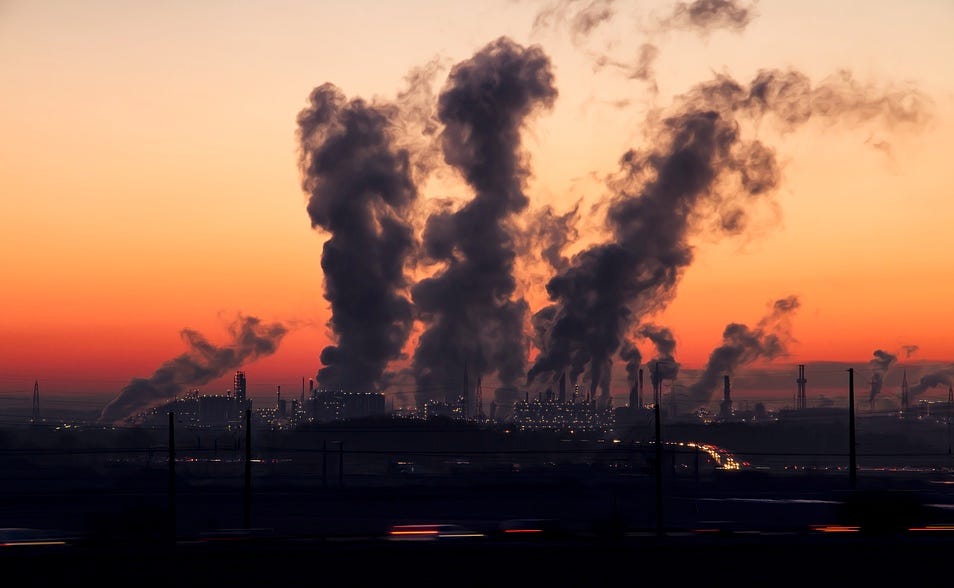Anti-ESG backlash gets Wall Street's attention, plus IEA signals climate 'doom loop'
Welcome to Callaway Climate Insights. Please enjoy, and share with your colleagues.
Today’s edition is free. To read our insights and support our great climate finance journalism four days a week, subscribe now for full access.
Something extraordinary happens in Yosemite National Park this time of year: Firefall. It’s when the last rays of the sun hit the waters of Horsetail Fall as they flow over the eastern edge of El Capitan in Yosemite Valley, transforming it from a waterfall to a firefall. The rare phenomenon comes from a combination of how El Capitan is shaped, the time of day, the angle of the sunlight, and the perfect weather conditions. Read more about Yosemite’s Firefall here. Photo: Images by John 'K'/flickr.
For all its ridiculous claims that environmental, social and governance (ESG) investing is some woke scheme to wreck the country, the anti-ESG movement is starting to snowball in Washington and on Wall Street.
Several of the largest fund managers and buyout firms, including BlackRock BLK 0.00%↑ , KKR, Carlyle Group and Blackstone Group BX 0.00%↑ have reportedly added wording to their annual reports that the backlash against sustainable investing could present a “material risk” to their businesses, particularly around fundraising.
When regulators pushed for ESG principles and climate risk to be included in financial documents, they never imagined it would be in this way. But the campaign from some far-right conservatives to stamp out sustainable investing options has now gotten Wall Street’s attention, and the White House.
Both the House and the Senate, with the help of closet Republican Joe Manchin (D-W. Va.) voted this week to block a Labor Department rule allowing retirement fund managers the option — the option — of accounting for ESG in their decisions. The resolution is expected to be vetoed by President Joe Biden and there are not enough votes to overturn it, but the vote shows that anti-ESG fervor has arrived as a major political issue for next year’s election season.
The real issue here isn’t whether accounting for climate risk in investment decisions is a good idea or not. Almost any money manager will tell you it is. The headline is that by using ESG as a wedge issue, the right wing has drawn political battle lines straight through national efforts to fight and prepare for climate change itself.
Don’t forget to contact me directly if you have suggestions or ideas at dcallaway@callawayclimateinsights.com.
Follow us . . . .
Twitter | LinkedIn | Facebook | Instagram
Time to break up the ESG gang, for the good of investors
. . . . We don’t make the world a better place by fixing everything all at once. The poet William Blake had a profound insight when he wrote: “He who would do good to another must do it in Minute Particulars.” So argues Mark Hulbert in this week’s column about ESG investing, saying that trying to combine environmental, social and governance (ESG) attributes into a single discipline is simply diluting them and leaving companies susceptible to manipulation. Companies and investment managers would do better for investors to break them up instead, which would allow for more measurable results. . . .
Investors still have faith in plant-based meat alternatives
. . . . Despite volatile conditions for plant-based meat companies such as Beyond Meat BYND 0.00%↑ and Impossible Foods, investment funds are still flowing into the alternative meat and protein ventures, writes Rebecca Barker from New York. Most of the money coming in is from the private markets, so it’s difficult to see vs. the public performance of Beyond Meat and Oatly OTLY 0.00%↑ , which both fell last year in line with other stocks in the Wall Street’s bear market. Genetic engineering research of food continues to draw interest, and analysts are bullish, despite concerns that consumer acceptance of such new foods might take longer than expected. . . .
Thursday’s subscriber-only insights
Energy report signals climate ‘doom loop’ upon us
. . . . The International Energy Agency’s annual energy use report Thursday came out largely as expected but with one troubling wrinkle. The report showed that carbon emissions rose in 2022 to a record high of 36.8 billion tons, with the worst spikes pegged to rising coal use in Asia. Massive growth in renewable energy helped blunt the added emissions, however, and we can expect renewable energy production to rise to levels to potentially meet 100% of global energy demand either this year or next.
The problem is that unlike the usual scapegoat for more coal and oil production — Russia’s invasion of Ukraine — the IEA singled out the increase in extreme weather such as heat and cold in pushing for more energy use, and more emissions. This is the scenario for the dreaded climate ‘doom loop,’ in which the more energy we need to handle rising climate disasters, the more emissions we create.
The clear signal from the IEA report is that all nations, including the U.S., must restructure their electric grids to be able to take all of the new renewable energy coming to market. For investors, that presents a major opportunity in the utilities and grid support businesses going forward. . . .
Beyond the headlines on the IEA report
. . . . At first glance, the headlines were contradictory. First, “Carbon dioxide emissions reached a record high in 2022.” And then “CO2 emissions may be starting to plateau, says global energy watchdog.” So, what’s going on here? We go beyond the headlines to assess if we are nearing a pollution plateau. Read more here. . . .
Deutsche Bank spotlights its fastest-growing area of sustainable revenue
. . . . One global financial firm apparently not suffering the ESG backlash is Deutsche Bank DB 0.00%↑ , which announced Thursday that it expects revenue from ESG business to grow to €1.4 billion ($1.48 billion) by 2025 from €800 billion last year. The bank said its fastest growing area of sustainable revenue is coming from its corporate bank, which does fixed-income financing among other things, and also its investment bank.
Deutsche Bank, of course, has less to worry about from the anti-ESG backlash, as it’s not based in the U.S., where the conservative party has made sustainable investing a woke concept. Its expectations must also be tempered against how it measures sustainable business, but most analysts expect a rebound in sustainable financing this year that should raise the tide for all ships, in Germany and otherwise. . . .
Activists pressure the enormously dirty shipping industry
. . . . America’s addiction to imported goods — and the decline of domestic manufacturing — brings with it a big pollution burden: Pollution from cargo ships. Who are the main retailers behind this somewhat hidden emissions scourge? Walmart leads the way. How can it be reduced? Read more here. . . .
Editor’s picks: The EV SUV equation; plus, the return of El Niño
EV SUVs are growing in popularity, but not fast enough
Electric SUVs are growing in popularity, but not quickly enough to offset the increasing oil consumption and emissions of the wider fleet, according to analysts with the International Energy Agency. In a commentary for IEA, global car markets did not have a good year in 2022, but SUVs were an exception, raising further concerns about their impact on efforts to tackle climate change. “SUVs require larger batteries to power them, so a growing electric SUV market would impose additional pressure on battery supply chains and further increase demand for the critical minerals needed to make the batteries.” Actions to mitigate those risks include downsizing of the average car size; increasing battery swapping; and investing in innovative battery technologies, the analysts said. “Those strategies would keep in check the investment requirements for developing the cobalt, copper, lithium and nickel resources needed to satisfy the increasing uptake of EVs.”
El Niño may return
A warming El Niño event may develop in the coming months after three consecutive years of an unusually stubborn and protracted La Niña that affected temperature and rainfall patterns around the world, according to an update Wednesday from the World Meteorological Organization. However, the WMO noted, while the return of El Nino is considered likely this will be preceded by a period of El Niño-Southern Oscillation, or ENSO-neutral conditions (90% probability) during March-May. The likelihood of ENSO-neutral conditions continuing beyond May decreases slightly but remains high. “The first triple-dip La Niña of the 21st century is finally coming to an end. La Niña’s cooling effect put a temporary brake on rising global temperatures, even though the past eight year period was the warmest on record,” said WMO Secretary-General Petteri Taalas. “If we do now enter an El Niño phase, this is likely to fuel another spike in global temperatures,” he said.
Latest findings: New research, studies and projects
After the deluge, the deficits
This paper, titled Natural Disasters and Fiscal Drought, examines to what extent slowdowns in economic growth after natural disasters are accompanied by widening fiscal deficits and corresponding pressures on public debt. From the abstract: Empirical analysis based on exogenous measures of physical disaster intensity shows that natural disasters lead not only to output losses but also to further deterioration of countries’ fiscal positions. The effects are persistent and driven by developments in emerging markets and developing economies. A dynamic stochastic general equilibrium model is used to show the propagation mechanism of an extreme event that affects agricultural productivity. Author: Lazar Milivojevic, World Bank.
More of the latest research:

Words to live by . . . .
“Study nature, love nature, stay close to nature. It will never fail you.” — Frank Lloyd Wright.







